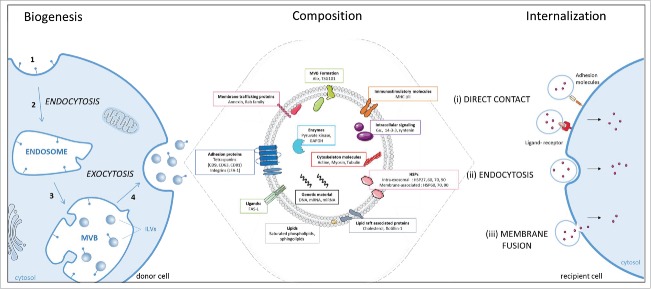Figure 1.
Scheme of exosomes biogenesis, composition and internalization. Biogenesis: the biogenesis of exosomes involves 4 different steps: (1) the membrane invagination; (2) endosome formation; (3) generation of the exosomes precursors, called intraluminal vesicles (ILVs), by inward budding of endosomes. These accumulations of ILVs is termed as multivesicular bodies (MVBs); (4) the fusion of MVBs with the plasma membrane release the ILVs in the extracellular space by exocytosis and become exosomes. Composition: Exosome are composed by different types of enzymes and proteins involved in: adhesion, traffic, intracellular signaling, immunostimulatory molecules, multivesicular body (MVB) formation and heat shock proteins (HSPs). Exosomes contain lipids such as (I) saturated phospholipids (phosphatidyl-ethanolamine, glycero-phospholipids, phosphatidyl-choline and phosphatidyl-serine) (ii) sphingolipids (ceramides), (iii) cholesterol. Finally, exosomes contain nucleic acids, including miRNA, mRNA, DNA and small non coding RNA (snRNA, tRNA). Internalization : The exosome may, (i) elicit transduction of the signal via intracellular signaling pathways by direct contact through adhesion molecules like integrin or through a ligand-receptor interaction, (ii) be endocytosed via phagocytosis, macropinocytosis or receptor-mediated endocytosis, or (iii) fusion with the plasma membrane and transfer its content into the cytoplasm of the recipient cell.

